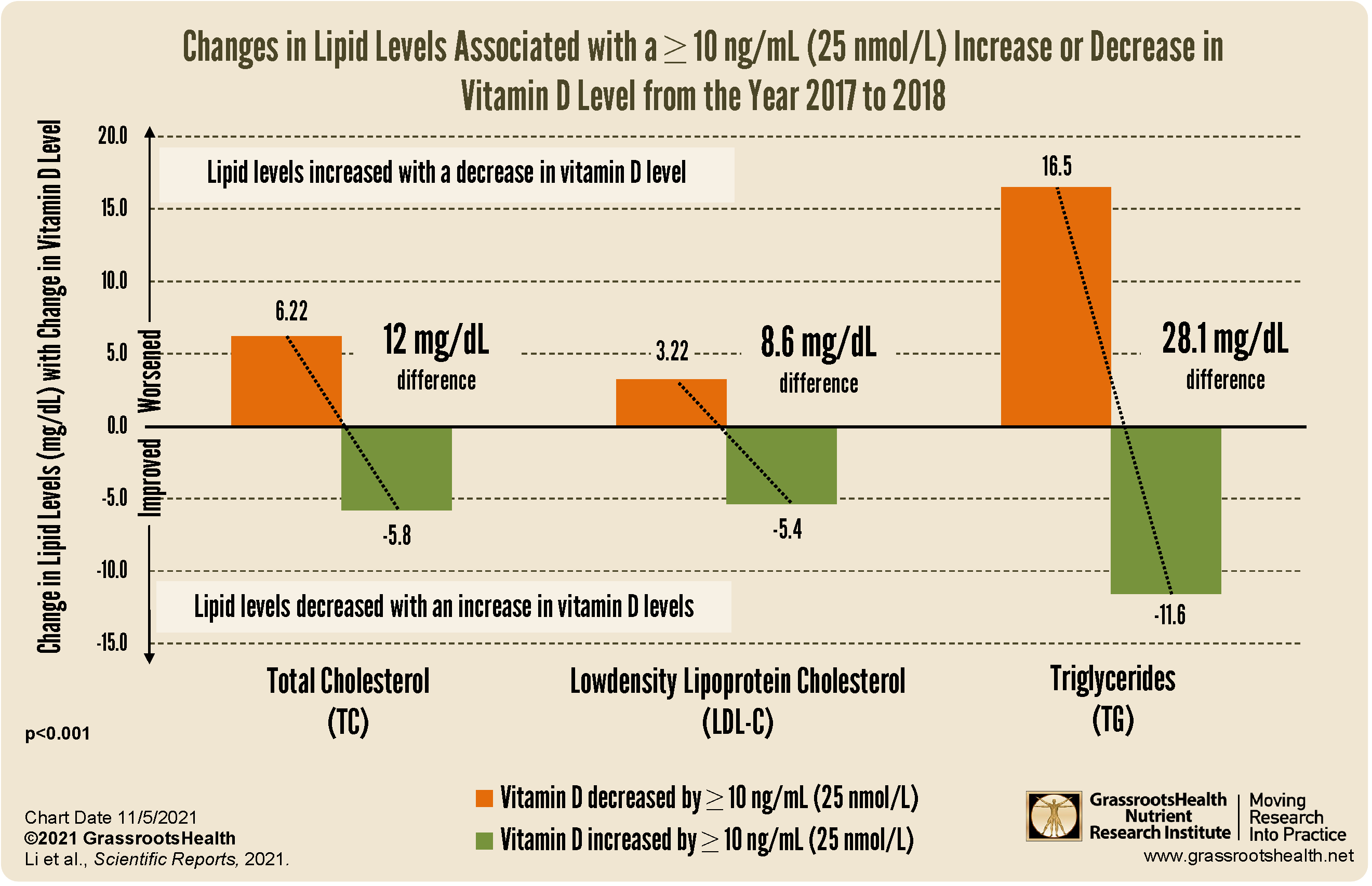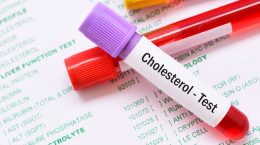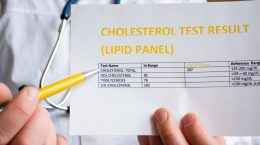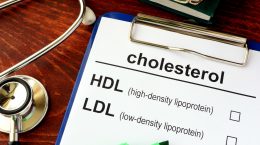Published on August 29, 2024
Is there a relationship between vitamin D levels and cholesterol levels, and how could one affect the other?
Key Points
- A year to year comparison found a significant decrease in TC, LDL-C, and TG levels among individuals whose vitamin D level had increased by 10 ng/ml or more, and an increase in TC, LDL-C, and TG levels among those whose vitamin D level had decreased by 10 ng/ml or more
- Changes in HDL-C were observed alongside changes in vitamin D levels, but these changes were slight and not statistically significant for all groups
- This study supports previous research showing that reductions in vitamin D levels are associated with worsening lipid profiles, and the authors suggest that vitamin D supplementation may be of benefit for individuals with dyslipidemia
- There is no universally agreed-upon “acceptable” cholesterol level specifically for optimal vitamin D3 production, as this process is influenced by various factors including overall health, skin exposure to sunlight, and individual metabolic conditions; however, some general guidelines can be considered
 Several questions about the relationship between vitamin D and cholesterol levels have been asked of us in the past, such as “Does increasing my vitamin D level or supplementing with vitamin D raise cholesterol levels,” or “Do vitamin D levels change with changing cholesterol levels?”
Several questions about the relationship between vitamin D and cholesterol levels have been asked of us in the past, such as “Does increasing my vitamin D level or supplementing with vitamin D raise cholesterol levels,” or “Do vitamin D levels change with changing cholesterol levels?”
We recently asked our followers to submit vitamin D related questions they have to the vitamin D researchers and experts. One of our followers asked:
7-dehydrocholesterol is converted into both cholesterol and vitamin D. It has been said that low cholesterol can compromise the production of Vitamin D3.
What is the acceptable level of cholesterol so that our body can produce vitamin D3 through sunlight?
See the response provided below by Dr. Satya Nahu, MD after reading our featured post.
Does Increasing Vitamin D Levels Also Raise Cholesterol Levels?
A recent study by Li et al. shows a significant relationship between changes in vitamin D levels and changes in lipid levels, with decreasing vitamin D linked to worsening lipid profile.
As can be seen in the chart, where orange bars indicate decreasing vitamin D levels and green bars indicate increasing vitamin D levels, TC, LDL-C, and TG levels increased (worsened) when the vitamin D level went down by at least 10 ng/ml (25 nmol/L) over the year and decreased (improved) when vitamin D level went up by at least 10 ng/ml over the year. For those whose vitamin D levels increased by 10 ng/ml (25 nmol/L) or more, compared to those whose levels decreased, there was an approximate reduction in
- Total Cholesterol by 10-12 mg/dL
- LDL-C by 7-8 mg/dL
- And Triglycerides by 21-28 mg/dL
These changes remained significant even after adjusting for age, sex, race, education, BMI, blood pressure, smoking status, geographical location, vitamin D level at baseline, and lipid level at baseline. While changes in HDL-C were observed, these changes were slight and not statistically significant for all groups.
This study supports previous research showing that reductions in vitamin D levels are associated with worsening lipid profiles, and the authors suggest that vitamin D supplementation may be of benefit for individuals with dyslipidemia.
Can Low Cholesterol Levels Compromise Vitamin D Production?
Here is the response provided by Dr. Satya L. Nahu, MD:
The relationship between cholesterol levels and vitamin D3 production is complex but important. Cholesterol is a precursor to vitamin D3 synthesis, as 7-dehydrocholesterol (a derivative of cholesterol) is converted to vitamin D3 when the skin is exposed to UVB radiation from sunlight.
There’s no universally agreed-upon “acceptable” cholesterol level specifically for optimal vitamin D3 production, as this process is influenced by various factors including overall health, skin exposure to sunlight, and individual metabolic conditions.
However, some general guidelines can be considered:
- Total Cholesterol Levels: Normal total cholesterol levels are generally considered to be less than 200 mg/dL. Levels above this might be associated with higher risks of cardiovascular issues, while levels below this are often viewed as more favorable for heart health.
- Optimal Range for Vitamin D Production: While specific cholesterol levels are not defined for vitamin D production, maintaining a balanced and healthy level of cholesterol is important. Very low cholesterol levels might theoretically impact the synthesis of vitamin D3, but the exact threshold where this becomes significant isn’t well-established.
- Overall Health Considerations: Rather than focusing on a specific cholesterol level for vitamin D synthesis, it’s more practical to ensure that cholesterol levels are within the recommended range for overall health. The focus should be on maintaining a healthy lifestyle, including adequate sun exposure and possibly vitamin D supplementation if needed to maintain a healthy vitamin D level.
If you have concerns about cholesterol levels and vitamin D synthesis, it’s best to consult with a healthcare provider. They can provide personalized advice based on your overall health profile and any specific needs you might have.
Additional scientific references that may be useful:
Warren, T.; McAllister, R.; Morgan, A.; Rai, T.S.; McGilligan, V.; Ennis, M.; Page, C.; Kelly, C.; Peace, A.; Corfe, B.M.; et al. The Interdependency and Co-Regulation of the Vitamin D and Cholesterol Metabolism. Cells 2021, 10, 2007. https://doi.org/10.3390/cells10082007
Singh, T., ., D., Sharma, L., Patel, P., & Kurmi, B. D. (2024). Exploring the Relationship between Cholesterol Synthesis and Vitamin D: Implications and Insight. International Journal of Newgen Research in Pharmacy & Healthcare, 2(1), 42–50. https://doi.org/10.61554/ijnrph.v2i1.2024.77
Submit Your Questions to the Vitamin D Scientists & Experts
Do you have a complex question about vitamin D that you feel needs to be answered by one of our vitamin D scientists/researchers, experts, or medical doctors and practitioners who have successfully and safely implemented vitamin D protocols into their practice?
Consider Donating to Support this Effort!
GrassrootsHealth works tirelessly to fight vitamin D misinformation. Please consider donating to support our efforts in educating individuals and health practitioners about vitamin D.
Vitamin D is an Easily Modifiable Factor to Help Improve Disease Outcomes – Make Sure You Are Getting Enough
 Having and maintaining healthy vitamin D levels and other nutrient levels can help improve your health now and for your future. Choose which to measure, such as your vitamin D, omega-3s, and essential minerals including magnesium and zinc, by creating your custom home test kit today. Take steps to improve the status of each of these measurements to benefit your overall health. You can also track your own intakes, symptoms and results to see what works best for YOU.
Having and maintaining healthy vitamin D levels and other nutrient levels can help improve your health now and for your future. Choose which to measure, such as your vitamin D, omega-3s, and essential minerals including magnesium and zinc, by creating your custom home test kit today. Take steps to improve the status of each of these measurements to benefit your overall health. You can also track your own intakes, symptoms and results to see what works best for YOU.
Enroll and test your levels today, learn what steps to take to improve your status of vitamin D (see below) and other nutrients and blood markers, and take action! By enrolling in the GrassrootsHealth projects, you are not only contributing valuable information to everyone, you are also gaining knowledge about how you could improve your own health through measuring and tracking your nutrient status, and educating yourself on how to improve it.






